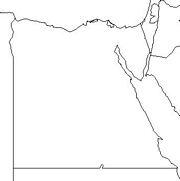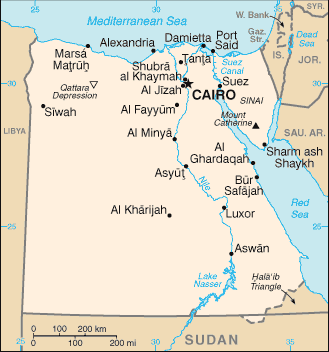
Click for printable map of Egypt
(Browse all the other World Maps.)
Map of Egypt links to other maps
- Outline – Unlabeled printer-friendly map of Egypt
- Shaded Relief – (click on the image to enlarge)
- Political – (click on the image to enlarge)
- Roads – Go to MapQuest and enter a city to get a custom map of Egypt.
- Earthquake Activity – Use the blue arrows to pan to other sections of the country.
- Languages
- Flags – A clickable map showing each of the governorate’s flags.
- eBook Maps – Free eBook maps for your eBook device.
For purchase
- Political Wall Map of Egypt – Large high-quality laminated wall map of Egypt. Exclusively developed by Maps.com and GRAPHI-OGRE and not available in any store, this wall map was created using high resolution vector digital imagery with state-of-the-art print on demand technology. Printed on 24lb. premium coated bond paper and laminated on both sides using 3mm laminate through a hot lamination process, this map is markable using dry erase pens and can be easily cleaned. Available in 3 sizes.
- Click here for all Egypt map products – Maps.com!
Egypt Of Interest
Covering an area of 386,660 square miles, Egypt is about the size of New Mexico, Utah, and Arizona combined. The terrain is made up of a vast desert plateau with the Nile valley bisecting the Eastern half of the country. The climate is desert; hot, dry summers with moderate winters. Its highest point is the 8626-foot Mount Catherine.

A unified kingdom arose around 3200 B.C. and a series of dynasties ruled in Egypt for the next 3000 years. The last native dynasty fell to the Persians in 341 B.C., who in turn were replaced by the Greeks, Romans, and Byzantines. The Arabs introduced Islam and the Arabic language in the 7th century and ruled for the next six centuries. A local military caste, the Mamluks took control about 1250 A.D. and continued to govern after the conquest of Egypt by the Ottoman Turks in 1517.
Following the completion of the Suez Canal in 1869, Egypt became an important world transportation hub. To protect its investments, Britain seized control of Egypt’s government in 1882, but some allegiance to the Ottoman Empire continued until 1914. Partially independent from the UK in 1922, Egypt acquired full sovereignty following World War II.
Egypt’s ethnic groups are made up of Eastern Hamitic stock (Egyptians, Bedouins, and Berbers) at 99% and Greek, Nubian, Armenian, other European (primarily Italian and French) at 1%. Muslim (mostly Sunni) is the dominant religion comprising 94% of the population while Coptic Christian and others are about 6%. Languages are mainly Arabic (official), English and French.
Industries include textiles, food processing, tourism, chemicals, hydrocarbons, construction, cement, and metals. Cotton, rice, corn, wheat, beans, fruits, vegetables, cattle, water buffalo, sheep, and goats are the chief agricultural products.